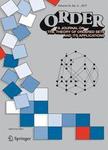版权所有:内蒙古大学图书馆 技术提供:维普资讯• 智图
内蒙古自治区呼和浩特市赛罕区大学西街235号 邮编: 010021

作者机构:Univ Luxembourg FSTC Math Res Unit L-1359 Luxembourg Luxembourg Univ Paris 01 Paris Sch Econ F-75013 Paris France
出 版 物:《ORDER-A JOURNAL ON THE THEORY OF ORDERED SETS AND ITS APPLICATIONS》 (序;有序集理论杂志)
年 卷 期:2013年第30卷第1期
页 面:269-288页
核心收录:
学科分类:07[理学] 0701[理学-数学] 070101[理学-基础数学]
主 题:Symmetric maximum Nonassociative algebra Computation rule Partially ordered set
摘 要:The symmetric maximum, denoted by a, is an extension of the usual maximum a operation so that 0 is the neutral element, and -aEuro parts per thousand x is the symmetric (or inverse) of x, i.e., x a aEuro parts per thousand( -aEuro parts per thousand x) = 0. However, such an extension does not preserve the associativity of a. This fact asks for systematic ways of parenthesing (or bracketing) terms of a sequence (with more than two arguments) when using such an extended maximum. We refer to such systematic (predefined) ways of parenthesing as computation rules. As it turns out there are infinitely many computation rules, each of which corresponds to a systematic way of bracketing arguments of sequences. Essentially, computation rules reduce to deleting terms of sequences based on the condition x a aEuro parts per thousand( -aEuro parts per thousand x) = 0. This observation gives raise to a quasi-order on the set of such computation rules: say that rule 1 is below rule 2 if for all sequences of numbers, rule 1 deletes more terms of the sequence than rule 2. In this paper we present a study of this quasi-ordering of computation rules. In particular, we show that the induced poset of all equivalence classes of computation rules is uncountably infinite, has infinitely many maximal elements, has infinitely many atoms, and it embeds the powerset of natural numbers ordered by inclusion.